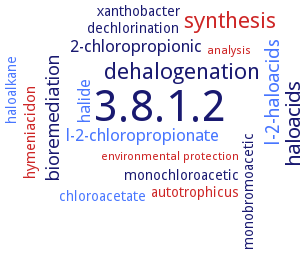Please wait a moment until all data is loaded. This message will disappear when all data is loaded.
Please wait a moment until the data is sorted. This message will disappear when the data is sorted.
D11E
-
totally inactive in catalysis
D11N
-
totally inactive in catalysis
D11S
-
totally inactive in catalysis
D181N
-
totally inactive in catalysis
N178D
-
defective in catalysis
D11E
-
totally inactive in catalysis
-
D11N
-
totally inactive in catalysis
-
D11S
-
totally inactive in catalysis
-
D181N
-
totally inactive in catalysis
-
D180A
-
site-directed mutagenesis of a residue that strongly interacts with the substrate
K151A
-
site-directed mutagenesis of a residue that strongly interacts with the substrate
S118A
-
mutant with lower specific activity and higher KM-value
S175A
-
site-directed mutagenesis of a residue that strongly interacts with the substrate
D180A
-
site-directed mutagenesis of a residue that strongly interacts with the substrate
-
K151A
-
site-directed mutagenesis of a residue that strongly interacts with the substrate
-
S118A
-
mutant with lower specific activity and higher KM-value
-
S175A
-
site-directed mutagenesis of a residue that strongly interacts with the substrate
-
D13A
significant decrease in the free energy of binding for the DehL-L-2-chloropropionic acid model complex, indicating the involvement of the residue in catalysis and/or structural integrity of the active site
H184A
significant decrease in the free energy of binding for the DehL-L-2-chloropropionic acid model complex, indicating the involvement of the residue in catalysis and/or structural integrity of the active site
H184Y
mutation significantly increases the binding strength of the enzyme towards D-2-chloropropionate
I186Y
mutation significantly increases the binding strength of the enzyme towards D-2-chloropropionate
M48A
significant decrease in the free energy of binding for the DehL-L-2-chloropropionic acid model complex, indicating the involvement of the residue in catalysis and/or structural integrity of the active site
R51A
significant decrease in the free energy of binding for the DehL-L-2-chloropropionic acid model complex, indicating the involvement of the residue in catalysis and/or structural integrity of the active site
R51L
mutation cancells out the dehalogenation activity of DehL towards it natural substrate, L-2-chloropropionate
R51L/M48R
mutation introduces a new activity towards D-2-chloropropionate, conveying the possibility of inverting the enantiospecificity of the enzyme from L-to D-enantiomer
T17A
significant decrease in the free energy of binding for the DehL-L-2-chloropropionic acid model complex, indicating the involvement of the residue in catalysis and/or structural integrity of the active site
D10N

-
Asn10 of the mutant enzyme is spontaneously deaminated to yield Asp, though slowly, causing increasing activity of the mutant preparation
D10N
-
Asn10 of the mutant enzyme is spontaneously deaminated to yield Asp, though slowly, causing increasing activity of the mutant preparation
-
additional information

-
mutant library with reduced activity
additional information
-
point mutations on 29 conserved charged and/or polar residues are generated and characterized
additional information
-
point mutations on 29 conserved charged and/or polar residues are generated and characterized
-
additional information
-
mutant library with reduced activity
-
additional information
-
-
additional information
-
diverse mutant types with higher KM-values and lower specific activity
additional information
-
mutant enzyme is constructed by introducing three lysyl residues at positions 11, 176 and 185 of enzyme by site-directed mutagenesis
additional information
-
mutants of all the 36 highly conserved charged and polar amino acid residues of enzyme, D10, D180, R41, K151, S118, S175, T14, Y157, and N177 play indispensable roles in the catalysis
additional information
-
diverse mutant types with higher KM-values and lower specific activity
-
additional information
-
mutant enzyme is constructed by introducing three lysyl residues at positions 11, 176 and 185 of enzyme by site-directed mutagenesis
-
additional information
-
-
-




 results (
results ( results (
results ( top
top






